Natural History Museum Report: Financial Operations and Governance
VerifiedAdded on 2022/12/28
|10
|2867
|60
Report
AI Summary
This report offers a detailed examination of the Natural History Museum, covering its organisational profile, objectives, consumer trends, sustainability initiatives, financial operations, governance structure, and key stakeholders. The report begins with an overview of the museum's history, location, and mission, highlighting its role as a major cultural institution. It then delves into the museum's five strategic objectives, including transforming the study of natural history, engaging a wide audience, securing its collection, developing its gardens and galleries, and creating a sustainable organisation. The report also analyses current consumer trends, such as the emphasis on sustainability, and how the museum is adapting to meet these trends through various projects and policies. Furthermore, the report outlines the financial operations, including sources of income and governance structure, highlighting the roles of trustees and key personnel. The report concludes with a discussion of the museum's key stakeholders and current issues it faces, providing a comprehensive overview of the Natural History Museum's operations and strategic direction.
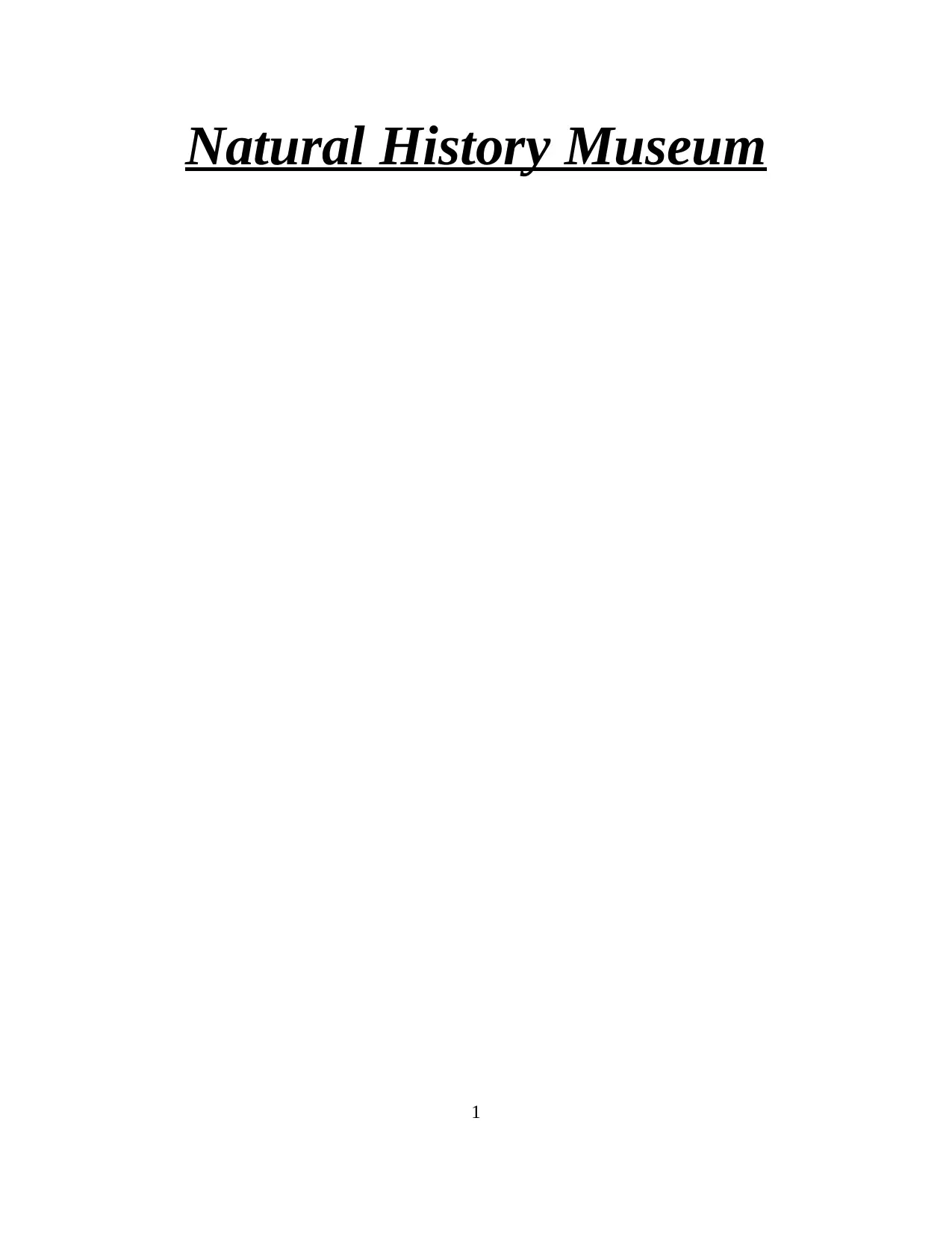
Natural History Museum
1
1
Paraphrase This Document
Need a fresh take? Get an instant paraphrase of this document with our AI Paraphraser
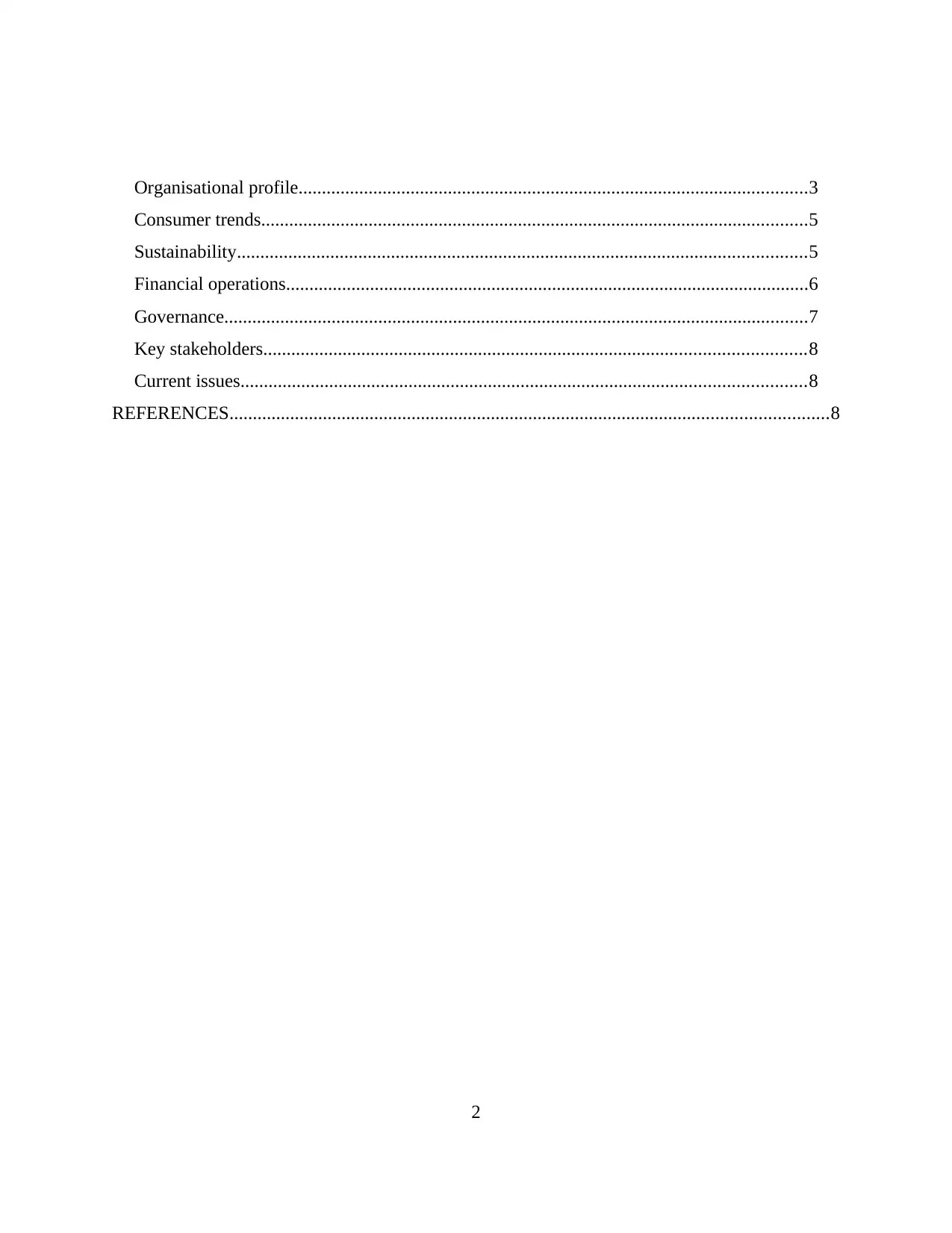
Organisational profile.............................................................................................................3
Consumer trends.....................................................................................................................5
Sustainability..........................................................................................................................5
Financial operations................................................................................................................6
Governance.............................................................................................................................7
Key stakeholders....................................................................................................................8
Current issues.........................................................................................................................8
REFERENCES................................................................................................................................8
2
Consumer trends.....................................................................................................................5
Sustainability..........................................................................................................................5
Financial operations................................................................................................................6
Governance.............................................................................................................................7
Key stakeholders....................................................................................................................8
Current issues.........................................................................................................................8
REFERENCES................................................................................................................................8
2
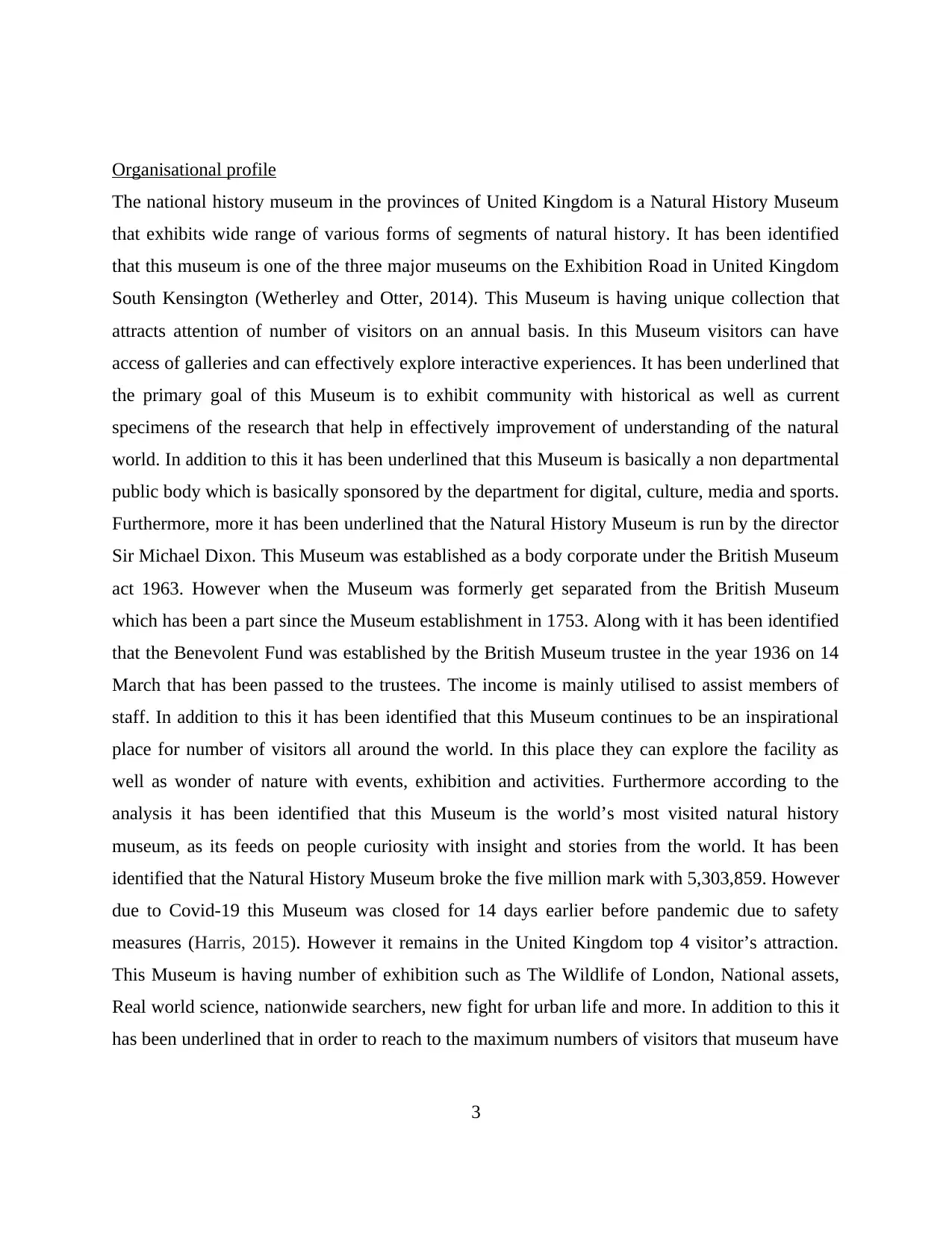
Organisational profile
The national history museum in the provinces of United Kingdom is a Natural History Museum
that exhibits wide range of various forms of segments of natural history. It has been identified
that this museum is one of the three major museums on the Exhibition Road in United Kingdom
South Kensington (Wetherley and Otter, 2014). This Museum is having unique collection that
attracts attention of number of visitors on an annual basis. In this Museum visitors can have
access of galleries and can effectively explore interactive experiences. It has been underlined that
the primary goal of this Museum is to exhibit community with historical as well as current
specimens of the research that help in effectively improvement of understanding of the natural
world. In addition to this it has been underlined that this Museum is basically a non departmental
public body which is basically sponsored by the department for digital, culture, media and sports.
Furthermore, more it has been underlined that the Natural History Museum is run by the director
Sir Michael Dixon. This Museum was established as a body corporate under the British Museum
act 1963. However when the Museum was formerly get separated from the British Museum
which has been a part since the Museum establishment in 1753. Along with it has been identified
that the Benevolent Fund was established by the British Museum trustee in the year 1936 on 14
March that has been passed to the trustees. The income is mainly utilised to assist members of
staff. In addition to this it has been identified that this Museum continues to be an inspirational
place for number of visitors all around the world. In this place they can explore the facility as
well as wonder of nature with events, exhibition and activities. Furthermore according to the
analysis it has been identified that this Museum is the world’s most visited natural history
museum, as its feeds on people curiosity with insight and stories from the world. It has been
identified that the Natural History Museum broke the five million mark with 5,303,859. However
due to Covid-19 this Museum was closed for 14 days earlier before pandemic due to safety
measures (Harris, 2015). However it remains in the United Kingdom top 4 visitor’s attraction.
This Museum is having number of exhibition such as The Wildlife of London, National assets,
Real world science, nationwide searchers, new fight for urban life and more. In addition to this it
has been underlined that in order to reach to the maximum numbers of visitors that museum have
3
The national history museum in the provinces of United Kingdom is a Natural History Museum
that exhibits wide range of various forms of segments of natural history. It has been identified
that this museum is one of the three major museums on the Exhibition Road in United Kingdom
South Kensington (Wetherley and Otter, 2014). This Museum is having unique collection that
attracts attention of number of visitors on an annual basis. In this Museum visitors can have
access of galleries and can effectively explore interactive experiences. It has been underlined that
the primary goal of this Museum is to exhibit community with historical as well as current
specimens of the research that help in effectively improvement of understanding of the natural
world. In addition to this it has been underlined that this Museum is basically a non departmental
public body which is basically sponsored by the department for digital, culture, media and sports.
Furthermore, more it has been underlined that the Natural History Museum is run by the director
Sir Michael Dixon. This Museum was established as a body corporate under the British Museum
act 1963. However when the Museum was formerly get separated from the British Museum
which has been a part since the Museum establishment in 1753. Along with it has been identified
that the Benevolent Fund was established by the British Museum trustee in the year 1936 on 14
March that has been passed to the trustees. The income is mainly utilised to assist members of
staff. In addition to this it has been identified that this Museum continues to be an inspirational
place for number of visitors all around the world. In this place they can explore the facility as
well as wonder of nature with events, exhibition and activities. Furthermore according to the
analysis it has been identified that this Museum is the world’s most visited natural history
museum, as its feeds on people curiosity with insight and stories from the world. It has been
identified that the Natural History Museum broke the five million mark with 5,303,859. However
due to Covid-19 this Museum was closed for 14 days earlier before pandemic due to safety
measures (Harris, 2015). However it remains in the United Kingdom top 4 visitor’s attraction.
This Museum is having number of exhibition such as The Wildlife of London, National assets,
Real world science, nationwide searchers, new fight for urban life and more. In addition to this it
has been underlined that in order to reach to the maximum numbers of visitors that museum have
3
⊘ This is a preview!⊘
Do you want full access?
Subscribe today to unlock all pages.

Trusted by 1+ million students worldwide
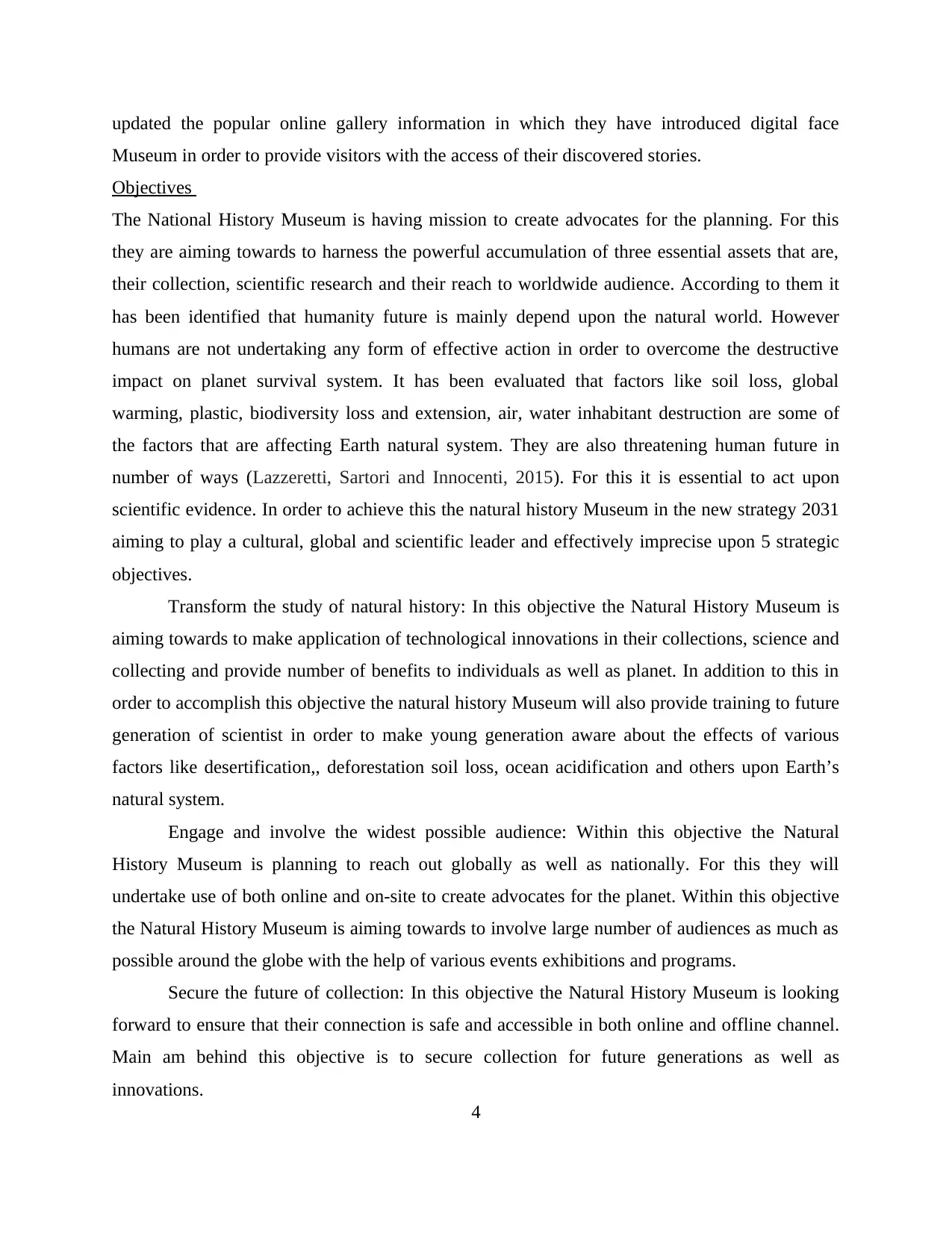
updated the popular online gallery information in which they have introduced digital face
Museum in order to provide visitors with the access of their discovered stories.
Objectives
The National History Museum is having mission to create advocates for the planning. For this
they are aiming towards to harness the powerful accumulation of three essential assets that are,
their collection, scientific research and their reach to worldwide audience. According to them it
has been identified that humanity future is mainly depend upon the natural world. However
humans are not undertaking any form of effective action in order to overcome the destructive
impact on planet survival system. It has been evaluated that factors like soil loss, global
warming, plastic, biodiversity loss and extension, air, water inhabitant destruction are some of
the factors that are affecting Earth natural system. They are also threatening human future in
number of ways (Lazzeretti, Sartori and Innocenti, 2015). For this it is essential to act upon
scientific evidence. In order to achieve this the natural history Museum in the new strategy 2031
aiming to play a cultural, global and scientific leader and effectively imprecise upon 5 strategic
objectives.
Transform the study of natural history: In this objective the Natural History Museum is
aiming towards to make application of technological innovations in their collections, science and
collecting and provide number of benefits to individuals as well as planet. In addition to this in
order to accomplish this objective the natural history Museum will also provide training to future
generation of scientist in order to make young generation aware about the effects of various
factors like desertification,, deforestation soil loss, ocean acidification and others upon Earth’s
natural system.
Engage and involve the widest possible audience: Within this objective the Natural
History Museum is planning to reach out globally as well as nationally. For this they will
undertake use of both online and on-site to create advocates for the planet. Within this objective
the Natural History Museum is aiming towards to involve large number of audiences as much as
possible around the globe with the help of various events exhibitions and programs.
Secure the future of collection: In this objective the Natural History Museum is looking
forward to ensure that their connection is safe and accessible in both online and offline channel.
Main am behind this objective is to secure collection for future generations as well as
innovations.
4
Museum in order to provide visitors with the access of their discovered stories.
Objectives
The National History Museum is having mission to create advocates for the planning. For this
they are aiming towards to harness the powerful accumulation of three essential assets that are,
their collection, scientific research and their reach to worldwide audience. According to them it
has been identified that humanity future is mainly depend upon the natural world. However
humans are not undertaking any form of effective action in order to overcome the destructive
impact on planet survival system. It has been evaluated that factors like soil loss, global
warming, plastic, biodiversity loss and extension, air, water inhabitant destruction are some of
the factors that are affecting Earth natural system. They are also threatening human future in
number of ways (Lazzeretti, Sartori and Innocenti, 2015). For this it is essential to act upon
scientific evidence. In order to achieve this the natural history Museum in the new strategy 2031
aiming to play a cultural, global and scientific leader and effectively imprecise upon 5 strategic
objectives.
Transform the study of natural history: In this objective the Natural History Museum is
aiming towards to make application of technological innovations in their collections, science and
collecting and provide number of benefits to individuals as well as planet. In addition to this in
order to accomplish this objective the natural history Museum will also provide training to future
generation of scientist in order to make young generation aware about the effects of various
factors like desertification,, deforestation soil loss, ocean acidification and others upon Earth’s
natural system.
Engage and involve the widest possible audience: Within this objective the Natural
History Museum is planning to reach out globally as well as nationally. For this they will
undertake use of both online and on-site to create advocates for the planet. Within this objective
the Natural History Museum is aiming towards to involve large number of audiences as much as
possible around the globe with the help of various events exhibitions and programs.
Secure the future of collection: In this objective the Natural History Museum is looking
forward to ensure that their connection is safe and accessible in both online and offline channel.
Main am behind this objective is to secure collection for future generations as well as
innovations.
4
Paraphrase This Document
Need a fresh take? Get an instant paraphrase of this document with our AI Paraphraser
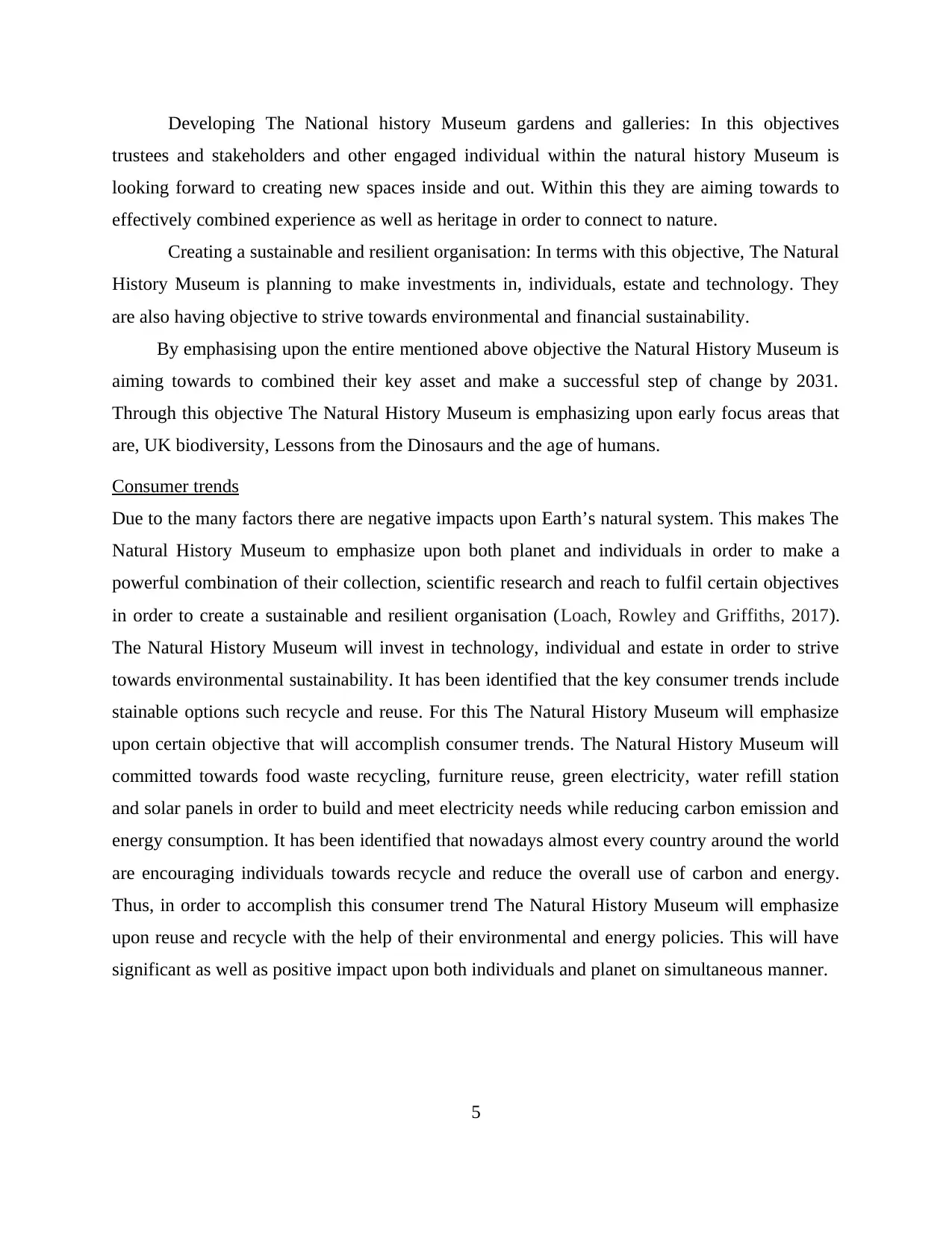
Developing The National history Museum gardens and galleries: In this objectives
trustees and stakeholders and other engaged individual within the natural history Museum is
looking forward to creating new spaces inside and out. Within this they are aiming towards to
effectively combined experience as well as heritage in order to connect to nature.
Creating a sustainable and resilient organisation: In terms with this objective, The Natural
History Museum is planning to make investments in, individuals, estate and technology. They
are also having objective to strive towards environmental and financial sustainability.
By emphasising upon the entire mentioned above objective the Natural History Museum is
aiming towards to combined their key asset and make a successful step of change by 2031.
Through this objective The Natural History Museum is emphasizing upon early focus areas that
are, UK biodiversity, Lessons from the Dinosaurs and the age of humans.
Consumer trends
Due to the many factors there are negative impacts upon Earth’s natural system. This makes The
Natural History Museum to emphasize upon both planet and individuals in order to make a
powerful combination of their collection, scientific research and reach to fulfil certain objectives
in order to create a sustainable and resilient organisation (Loach, Rowley and Griffiths, 2017).
The Natural History Museum will invest in technology, individual and estate in order to strive
towards environmental sustainability. It has been identified that the key consumer trends include
stainable options such recycle and reuse. For this The Natural History Museum will emphasize
upon certain objective that will accomplish consumer trends. The Natural History Museum will
committed towards food waste recycling, furniture reuse, green electricity, water refill station
and solar panels in order to build and meet electricity needs while reducing carbon emission and
energy consumption. It has been identified that nowadays almost every country around the world
are encouraging individuals towards recycle and reduce the overall use of carbon and energy.
Thus, in order to accomplish this consumer trend The Natural History Museum will emphasize
upon reuse and recycle with the help of their environmental and energy policies. This will have
significant as well as positive impact upon both individuals and planet on simultaneous manner.
5
trustees and stakeholders and other engaged individual within the natural history Museum is
looking forward to creating new spaces inside and out. Within this they are aiming towards to
effectively combined experience as well as heritage in order to connect to nature.
Creating a sustainable and resilient organisation: In terms with this objective, The Natural
History Museum is planning to make investments in, individuals, estate and technology. They
are also having objective to strive towards environmental and financial sustainability.
By emphasising upon the entire mentioned above objective the Natural History Museum is
aiming towards to combined their key asset and make a successful step of change by 2031.
Through this objective The Natural History Museum is emphasizing upon early focus areas that
are, UK biodiversity, Lessons from the Dinosaurs and the age of humans.
Consumer trends
Due to the many factors there are negative impacts upon Earth’s natural system. This makes The
Natural History Museum to emphasize upon both planet and individuals in order to make a
powerful combination of their collection, scientific research and reach to fulfil certain objectives
in order to create a sustainable and resilient organisation (Loach, Rowley and Griffiths, 2017).
The Natural History Museum will invest in technology, individual and estate in order to strive
towards environmental sustainability. It has been identified that the key consumer trends include
stainable options such recycle and reuse. For this The Natural History Museum will emphasize
upon certain objective that will accomplish consumer trends. The Natural History Museum will
committed towards food waste recycling, furniture reuse, green electricity, water refill station
and solar panels in order to build and meet electricity needs while reducing carbon emission and
energy consumption. It has been identified that nowadays almost every country around the world
are encouraging individuals towards recycle and reduce the overall use of carbon and energy.
Thus, in order to accomplish this consumer trend The Natural History Museum will emphasize
upon reuse and recycle with the help of their environmental and energy policies. This will have
significant as well as positive impact upon both individuals and planet on simultaneous manner.
5
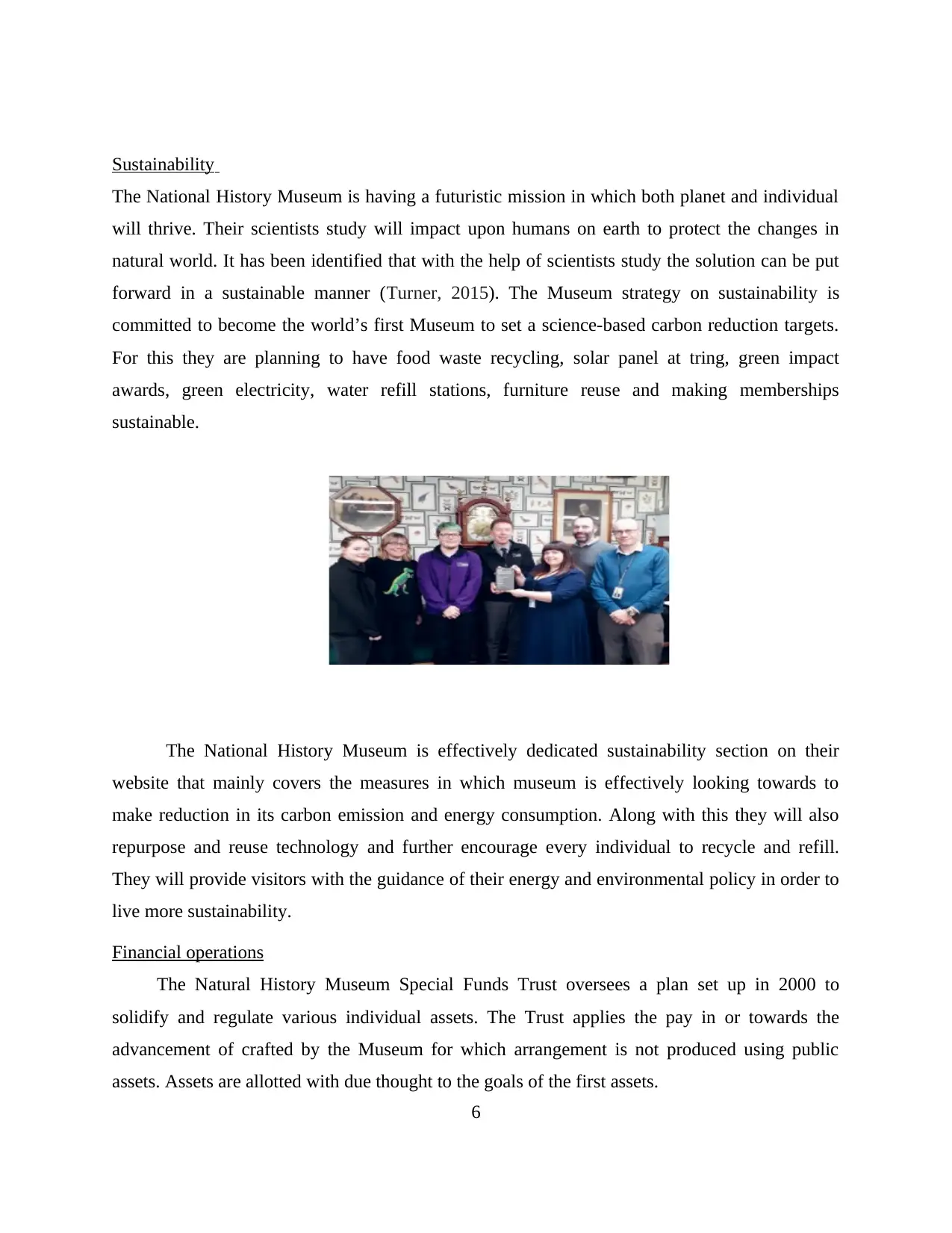
Sustainability
The National History Museum is having a futuristic mission in which both planet and individual
will thrive. Their scientists study will impact upon humans on earth to protect the changes in
natural world. It has been identified that with the help of scientists study the solution can be put
forward in a sustainable manner (Turner, 2015). The Museum strategy on sustainability is
committed to become the world’s first Museum to set a science-based carbon reduction targets.
For this they are planning to have food waste recycling, solar panel at tring, green impact
awards, green electricity, water refill stations, furniture reuse and making memberships
sustainable.
The National History Museum is effectively dedicated sustainability section on their
website that mainly covers the measures in which museum is effectively looking towards to
make reduction in its carbon emission and energy consumption. Along with this they will also
repurpose and reuse technology and further encourage every individual to recycle and refill.
They will provide visitors with the guidance of their energy and environmental policy in order to
live more sustainability.
Financial operations
The Natural History Museum Special Funds Trust oversees a plan set up in 2000 to
solidify and regulate various individual assets. The Trust applies the pay in or towards the
advancement of crafted by the Museum for which arrangement is not produced using public
assets. Assets are allotted with due thought to the goals of the first assets.
6
The National History Museum is having a futuristic mission in which both planet and individual
will thrive. Their scientists study will impact upon humans on earth to protect the changes in
natural world. It has been identified that with the help of scientists study the solution can be put
forward in a sustainable manner (Turner, 2015). The Museum strategy on sustainability is
committed to become the world’s first Museum to set a science-based carbon reduction targets.
For this they are planning to have food waste recycling, solar panel at tring, green impact
awards, green electricity, water refill stations, furniture reuse and making memberships
sustainable.
The National History Museum is effectively dedicated sustainability section on their
website that mainly covers the measures in which museum is effectively looking towards to
make reduction in its carbon emission and energy consumption. Along with this they will also
repurpose and reuse technology and further encourage every individual to recycle and refill.
They will provide visitors with the guidance of their energy and environmental policy in order to
live more sustainability.
Financial operations
The Natural History Museum Special Funds Trust oversees a plan set up in 2000 to
solidify and regulate various individual assets. The Trust applies the pay in or towards the
advancement of crafted by the Museum for which arrangement is not produced using public
assets. Assets are allotted with due thought to the goals of the first assets.
6
⊘ This is a preview!⊘
Do you want full access?
Subscribe today to unlock all pages.

Trusted by 1+ million students worldwide
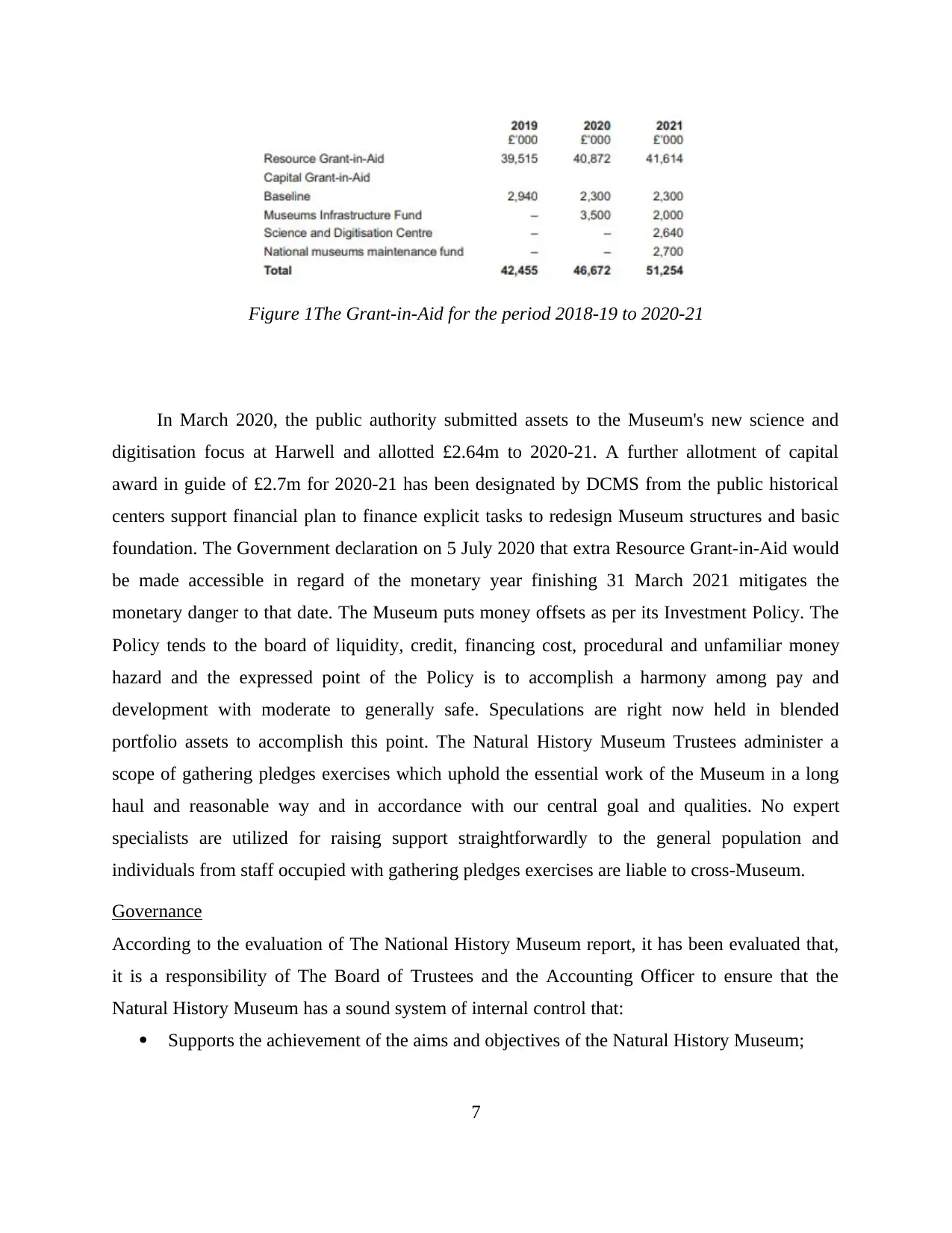
Figure 1The Grant-in-Aid for the period 2018-19 to 2020-21
In March 2020, the public authority submitted assets to the Museum's new science and
digitisation focus at Harwell and allotted £2.64m to 2020-21. A further allotment of capital
award in guide of £2.7m for 2020-21 has been designated by DCMS from the public historical
centers support financial plan to finance explicit tasks to redesign Museum structures and basic
foundation. The Government declaration on 5 July 2020 that extra Resource Grant-in-Aid would
be made accessible in regard of the monetary year finishing 31 March 2021 mitigates the
monetary danger to that date. The Museum puts money offsets as per its Investment Policy. The
Policy tends to the board of liquidity, credit, financing cost, procedural and unfamiliar money
hazard and the expressed point of the Policy is to accomplish a harmony among pay and
development with moderate to generally safe. Speculations are right now held in blended
portfolio assets to accomplish this point. The Natural History Museum Trustees administer a
scope of gathering pledges exercises which uphold the essential work of the Museum in a long
haul and reasonable way and in accordance with our central goal and qualities. No expert
specialists are utilized for raising support straightforwardly to the general population and
individuals from staff occupied with gathering pledges exercises are liable to cross-Museum.
Governance
According to the evaluation of The National History Museum report, it has been evaluated that,
it is a responsibility of The Board of Trustees and the Accounting Officer to ensure that the
Natural History Museum has a sound system of internal control that:
Supports the achievement of the aims and objectives of the Natural History Museum;
7
In March 2020, the public authority submitted assets to the Museum's new science and
digitisation focus at Harwell and allotted £2.64m to 2020-21. A further allotment of capital
award in guide of £2.7m for 2020-21 has been designated by DCMS from the public historical
centers support financial plan to finance explicit tasks to redesign Museum structures and basic
foundation. The Government declaration on 5 July 2020 that extra Resource Grant-in-Aid would
be made accessible in regard of the monetary year finishing 31 March 2021 mitigates the
monetary danger to that date. The Museum puts money offsets as per its Investment Policy. The
Policy tends to the board of liquidity, credit, financing cost, procedural and unfamiliar money
hazard and the expressed point of the Policy is to accomplish a harmony among pay and
development with moderate to generally safe. Speculations are right now held in blended
portfolio assets to accomplish this point. The Natural History Museum Trustees administer a
scope of gathering pledges exercises which uphold the essential work of the Museum in a long
haul and reasonable way and in accordance with our central goal and qualities. No expert
specialists are utilized for raising support straightforwardly to the general population and
individuals from staff occupied with gathering pledges exercises are liable to cross-Museum.
Governance
According to the evaluation of The National History Museum report, it has been evaluated that,
it is a responsibility of The Board of Trustees and the Accounting Officer to ensure that the
Natural History Museum has a sound system of internal control that:
Supports the achievement of the aims and objectives of the Natural History Museum;
7
Paraphrase This Document
Need a fresh take? Get an instant paraphrase of this document with our AI Paraphraser
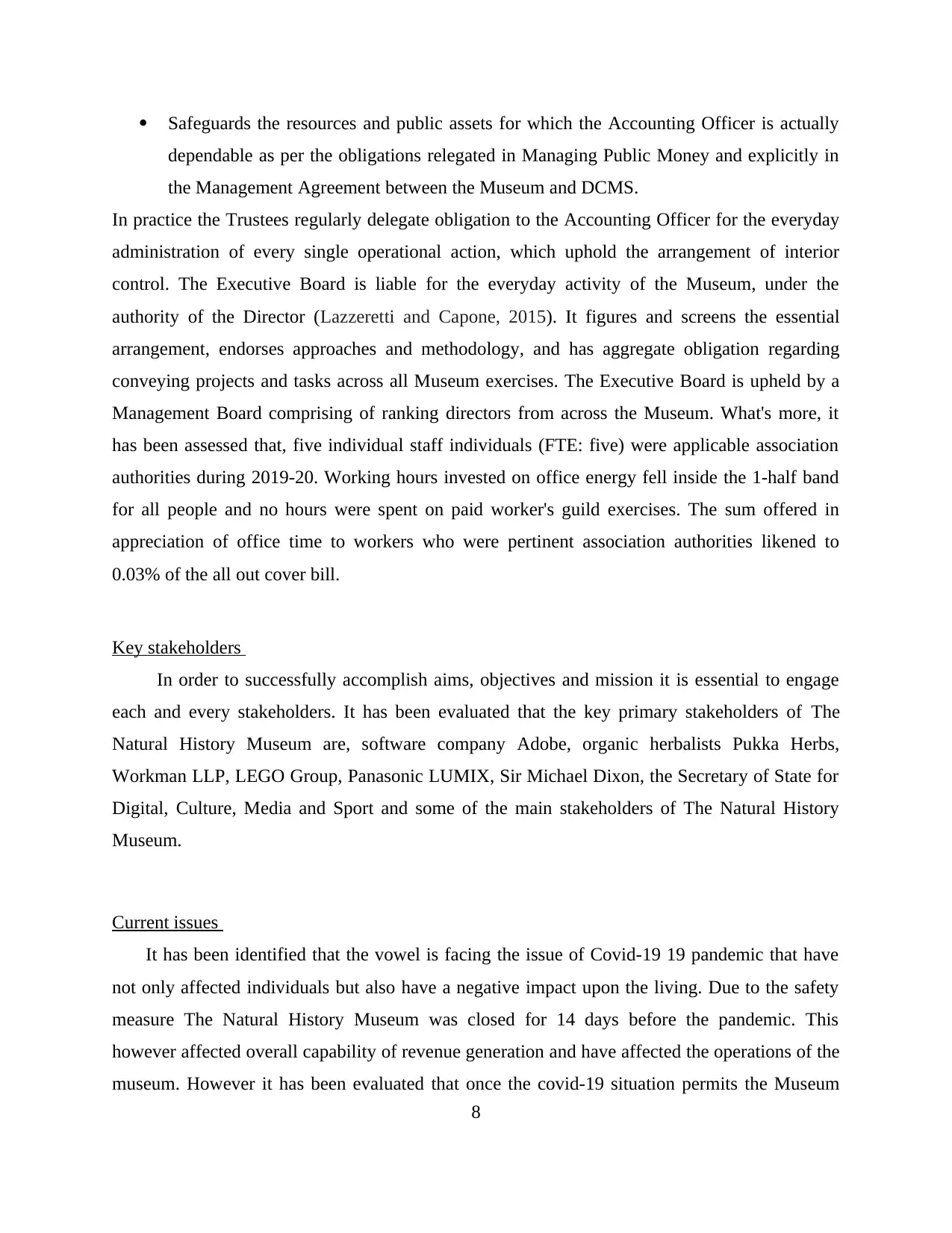
Safeguards the resources and public assets for which the Accounting Officer is actually
dependable as per the obligations relegated in Managing Public Money and explicitly in
the Management Agreement between the Museum and DCMS.
In practice the Trustees regularly delegate obligation to the Accounting Officer for the everyday
administration of every single operational action, which uphold the arrangement of interior
control. The Executive Board is liable for the everyday activity of the Museum, under the
authority of the Director (Lazzeretti and Capone, 2015). It figures and screens the essential
arrangement, endorses approaches and methodology, and has aggregate obligation regarding
conveying projects and tasks across all Museum exercises. The Executive Board is upheld by a
Management Board comprising of ranking directors from across the Museum. What's more, it
has been assessed that, five individual staff individuals (FTE: five) were applicable association
authorities during 2019-20. Working hours invested on office energy fell inside the 1-half band
for all people and no hours were spent on paid worker's guild exercises. The sum offered in
appreciation of office time to workers who were pertinent association authorities likened to
0.03% of the all out cover bill.
Key stakeholders
In order to successfully accomplish aims, objectives and mission it is essential to engage
each and every stakeholders. It has been evaluated that the key primary stakeholders of The
Natural History Museum are, software company Adobe, organic herbalists Pukka Herbs,
Workman LLP, LEGO Group, Panasonic LUMIX, Sir Michael Dixon, the Secretary of State for
Digital, Culture, Media and Sport and some of the main stakeholders of The Natural History
Museum.
Current issues
It has been identified that the vowel is facing the issue of Covid-19 19 pandemic that have
not only affected individuals but also have a negative impact upon the living. Due to the safety
measure The Natural History Museum was closed for 14 days before the pandemic. This
however affected overall capability of revenue generation and have affected the operations of the
museum. However it has been evaluated that once the covid-19 situation permits the Museum
8
dependable as per the obligations relegated in Managing Public Money and explicitly in
the Management Agreement between the Museum and DCMS.
In practice the Trustees regularly delegate obligation to the Accounting Officer for the everyday
administration of every single operational action, which uphold the arrangement of interior
control. The Executive Board is liable for the everyday activity of the Museum, under the
authority of the Director (Lazzeretti and Capone, 2015). It figures and screens the essential
arrangement, endorses approaches and methodology, and has aggregate obligation regarding
conveying projects and tasks across all Museum exercises. The Executive Board is upheld by a
Management Board comprising of ranking directors from across the Museum. What's more, it
has been assessed that, five individual staff individuals (FTE: five) were applicable association
authorities during 2019-20. Working hours invested on office energy fell inside the 1-half band
for all people and no hours were spent on paid worker's guild exercises. The sum offered in
appreciation of office time to workers who were pertinent association authorities likened to
0.03% of the all out cover bill.
Key stakeholders
In order to successfully accomplish aims, objectives and mission it is essential to engage
each and every stakeholders. It has been evaluated that the key primary stakeholders of The
Natural History Museum are, software company Adobe, organic herbalists Pukka Herbs,
Workman LLP, LEGO Group, Panasonic LUMIX, Sir Michael Dixon, the Secretary of State for
Digital, Culture, Media and Sport and some of the main stakeholders of The Natural History
Museum.
Current issues
It has been identified that the vowel is facing the issue of Covid-19 19 pandemic that have
not only affected individuals but also have a negative impact upon the living. Due to the safety
measure The Natural History Museum was closed for 14 days before the pandemic. This
however affected overall capability of revenue generation and have affected the operations of the
museum. However it has been evaluated that once the covid-19 situation permits the Museum
8
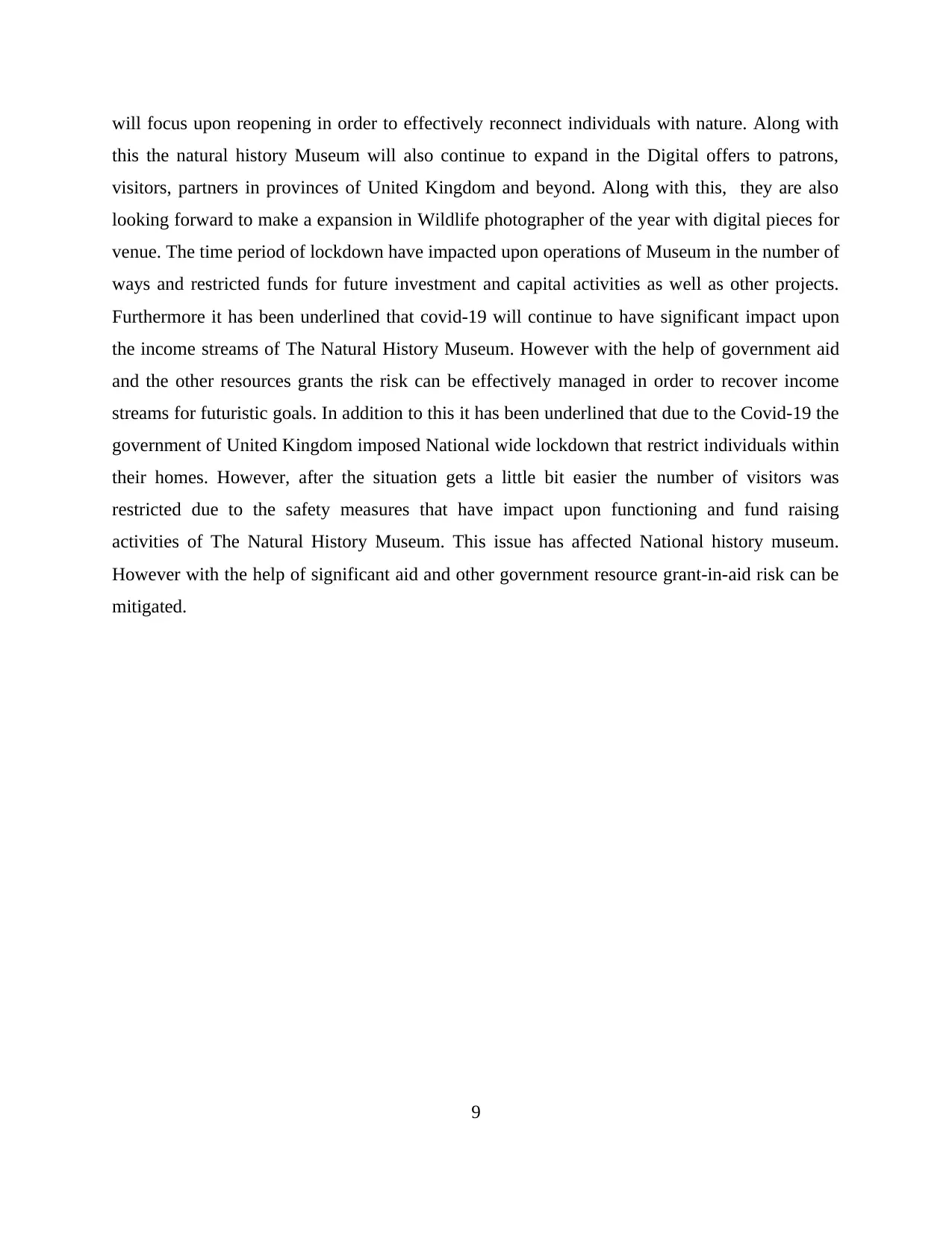
will focus upon reopening in order to effectively reconnect individuals with nature. Along with
this the natural history Museum will also continue to expand in the Digital offers to patrons,
visitors, partners in provinces of United Kingdom and beyond. Along with this, they are also
looking forward to make a expansion in Wildlife photographer of the year with digital pieces for
venue. The time period of lockdown have impacted upon operations of Museum in the number of
ways and restricted funds for future investment and capital activities as well as other projects.
Furthermore it has been underlined that covid-19 will continue to have significant impact upon
the income streams of The Natural History Museum. However with the help of government aid
and the other resources grants the risk can be effectively managed in order to recover income
streams for futuristic goals. In addition to this it has been underlined that due to the Covid-19 the
government of United Kingdom imposed National wide lockdown that restrict individuals within
their homes. However, after the situation gets a little bit easier the number of visitors was
restricted due to the safety measures that have impact upon functioning and fund raising
activities of The Natural History Museum. This issue has affected National history museum.
However with the help of significant aid and other government resource grant-in-aid risk can be
mitigated.
9
this the natural history Museum will also continue to expand in the Digital offers to patrons,
visitors, partners in provinces of United Kingdom and beyond. Along with this, they are also
looking forward to make a expansion in Wildlife photographer of the year with digital pieces for
venue. The time period of lockdown have impacted upon operations of Museum in the number of
ways and restricted funds for future investment and capital activities as well as other projects.
Furthermore it has been underlined that covid-19 will continue to have significant impact upon
the income streams of The Natural History Museum. However with the help of government aid
and the other resources grants the risk can be effectively managed in order to recover income
streams for futuristic goals. In addition to this it has been underlined that due to the Covid-19 the
government of United Kingdom imposed National wide lockdown that restrict individuals within
their homes. However, after the situation gets a little bit easier the number of visitors was
restricted due to the safety measures that have impact upon functioning and fund raising
activities of The Natural History Museum. This issue has affected National history museum.
However with the help of significant aid and other government resource grant-in-aid risk can be
mitigated.
9
⊘ This is a preview!⊘
Do you want full access?
Subscribe today to unlock all pages.

Trusted by 1+ million students worldwide
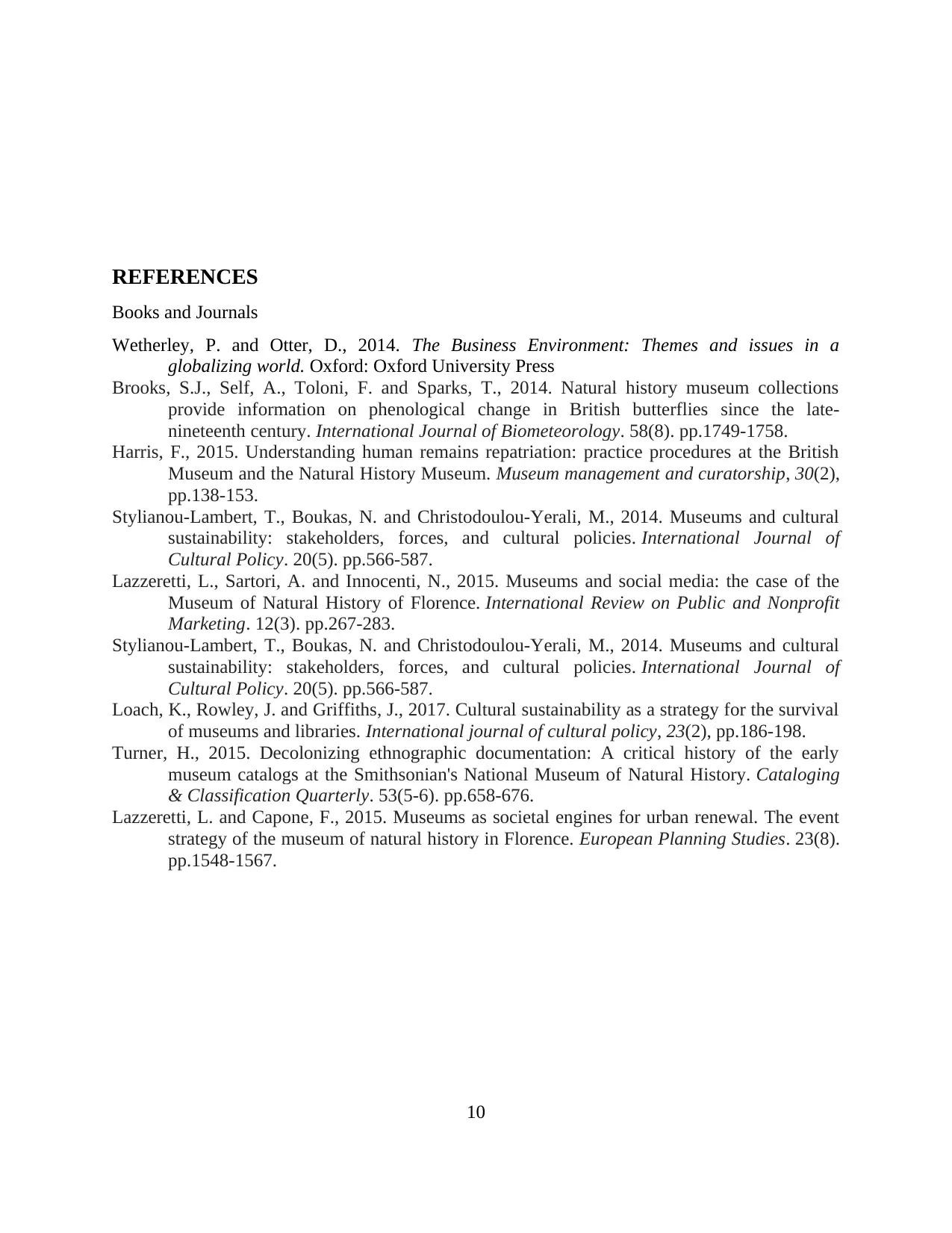
REFERENCES
Books and Journals
Wetherley, P. and Otter, D., 2014. The Business Environment: Themes and issues in a
globalizing world. Oxford: Oxford University Press
Brooks, S.J., Self, A., Toloni, F. and Sparks, T., 2014. Natural history museum collections
provide information on phenological change in British butterflies since the late-
nineteenth century. International Journal of Biometeorology. 58(8). pp.1749-1758.
Harris, F., 2015. Understanding human remains repatriation: practice procedures at the British
Museum and the Natural History Museum. Museum management and curatorship, 30(2),
pp.138-153.
Stylianou-Lambert, T., Boukas, N. and Christodoulou-Yerali, M., 2014. Museums and cultural
sustainability: stakeholders, forces, and cultural policies. International Journal of
Cultural Policy. 20(5). pp.566-587.
Lazzeretti, L., Sartori, A. and Innocenti, N., 2015. Museums and social media: the case of the
Museum of Natural History of Florence. International Review on Public and Nonprofit
Marketing. 12(3). pp.267-283.
Stylianou-Lambert, T., Boukas, N. and Christodoulou-Yerali, M., 2014. Museums and cultural
sustainability: stakeholders, forces, and cultural policies. International Journal of
Cultural Policy. 20(5). pp.566-587.
Loach, K., Rowley, J. and Griffiths, J., 2017. Cultural sustainability as a strategy for the survival
of museums and libraries. International journal of cultural policy, 23(2), pp.186-198.
Turner, H., 2015. Decolonizing ethnographic documentation: A critical history of the early
museum catalogs at the Smithsonian's National Museum of Natural History. Cataloging
& Classification Quarterly. 53(5-6). pp.658-676.
Lazzeretti, L. and Capone, F., 2015. Museums as societal engines for urban renewal. The event
strategy of the museum of natural history in Florence. European Planning Studies. 23(8).
pp.1548-1567.
10
Books and Journals
Wetherley, P. and Otter, D., 2014. The Business Environment: Themes and issues in a
globalizing world. Oxford: Oxford University Press
Brooks, S.J., Self, A., Toloni, F. and Sparks, T., 2014. Natural history museum collections
provide information on phenological change in British butterflies since the late-
nineteenth century. International Journal of Biometeorology. 58(8). pp.1749-1758.
Harris, F., 2015. Understanding human remains repatriation: practice procedures at the British
Museum and the Natural History Museum. Museum management and curatorship, 30(2),
pp.138-153.
Stylianou-Lambert, T., Boukas, N. and Christodoulou-Yerali, M., 2014. Museums and cultural
sustainability: stakeholders, forces, and cultural policies. International Journal of
Cultural Policy. 20(5). pp.566-587.
Lazzeretti, L., Sartori, A. and Innocenti, N., 2015. Museums and social media: the case of the
Museum of Natural History of Florence. International Review on Public and Nonprofit
Marketing. 12(3). pp.267-283.
Stylianou-Lambert, T., Boukas, N. and Christodoulou-Yerali, M., 2014. Museums and cultural
sustainability: stakeholders, forces, and cultural policies. International Journal of
Cultural Policy. 20(5). pp.566-587.
Loach, K., Rowley, J. and Griffiths, J., 2017. Cultural sustainability as a strategy for the survival
of museums and libraries. International journal of cultural policy, 23(2), pp.186-198.
Turner, H., 2015. Decolonizing ethnographic documentation: A critical history of the early
museum catalogs at the Smithsonian's National Museum of Natural History. Cataloging
& Classification Quarterly. 53(5-6). pp.658-676.
Lazzeretti, L. and Capone, F., 2015. Museums as societal engines for urban renewal. The event
strategy of the museum of natural history in Florence. European Planning Studies. 23(8).
pp.1548-1567.
10
1 out of 10
Related Documents
Your All-in-One AI-Powered Toolkit for Academic Success.
+13062052269
info@desklib.com
Available 24*7 on WhatsApp / Email
![[object Object]](/_next/static/media/star-bottom.7253800d.svg)
Unlock your academic potential
Copyright © 2020–2025 A2Z Services. All Rights Reserved. Developed and managed by ZUCOL.




